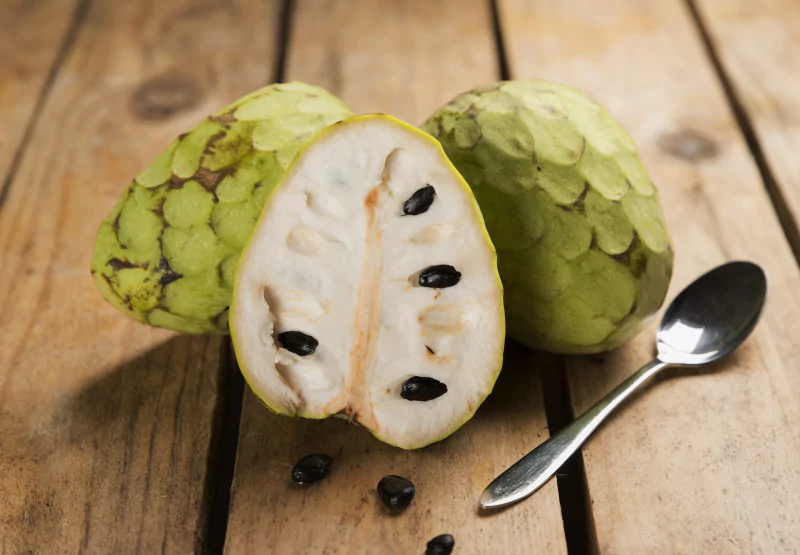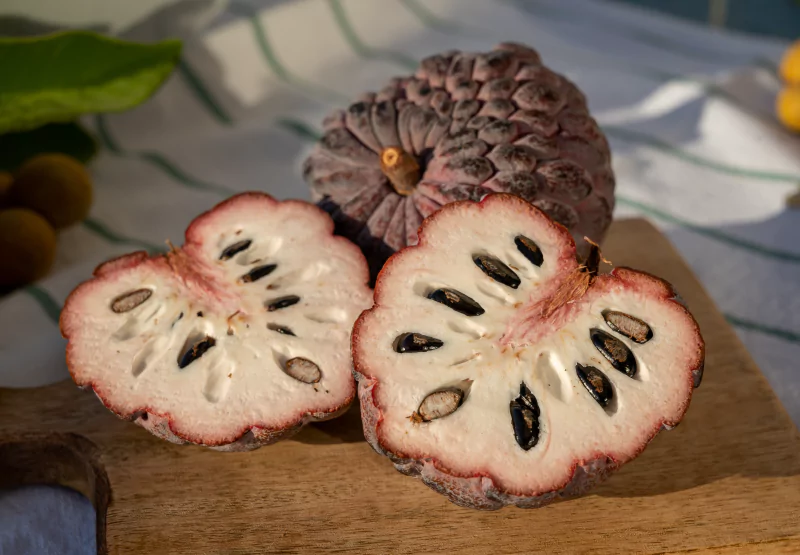Custard Apples: 7 Surprising Health Benefits

Key Takeways
Have you ever heard of a custard apple? This fruit, also called cherimoya, sitaphal, or sugar apple, is a type of tropical fruit known for its sweet flavor and vanilla-like smell.
But beyond their luscious smell and texture, some believe they contain additional health benefits which mostly stem from their antioxidant content. The leaves of the custard apple are even used as a form of natural medicine in many parts of the world.
Want to learn more about custard apples? Keep reading!
Where are Custard Apples From?
Custard apples originated in South America and the West Indies, and were an important part of the diet of indigenous peoples in those areas. Today, custard apples are cultivated in Asia, Australia, Spain, Israel, India, and other warm climates.
The name custard apple actually refers to both the fruit and the deciduous tree that grows it. While it holds the shape of a typical apple, a custard apple has green, leathery skin that is bumpy and heavily dimpled.
Inside, the pulp is white or yellowish, sweet, and very soft in texture. The inside of a custard apple has large black seeds that represent watermelon seeds.
7 Health Benefits of Custard Apples
So, is the custard apple a healthy fruit? Here’s what you need to know:

Just one cup of the pulp of a custard apple provides the following macronutrients:
- 59 grams of carbohydrates
- 5.2 grams of protein
- 11 grams of dietary fiber
- 0.7 grams of fat
The same serving size of a custard apple contains 235 calories and is a source of nutrients like iron, vitamin A, vitamin C, vitamin B6, potassium, magnesium, calcium, and phosphorus.
If the impressive vitamin and mineral content of this fruit hasn’t impressed you, here are a few more reasons why you may want to start snacking on custard apples.
1) Contain Beneficial Antioxidants
Custard apples are brimming with antioxidants called carotenoids. Their leaves contain phenols, flavonoids, and other bioactive compounds that may have anticancer, antimicrobial, antidiabetic, and anti-inflammatory properties.
Antioxidants help fight off free radicals in the body, which are shown to increase the risk for several chronic illnesses. However, more studies are needed to determine the full impact of plant-based bioactive compounds as sources of antioxidants in the body, since their metabolism may be complex.
Custard apple leaves are widely used as a dietary supplement for the treatment of diabetes. If you are living with diabetes, make sure to talk to your doctor before taking any new supplements.
2) May Help Lower Blood Pressure

Custard apples are brimming with potassium—one cup contains 618 milligrams. Studies show that dietary potassium can significantly lower blood pressure.
A high intake of fruits rich in potassium may improve blood pressure levels, reducing the risk of heart disease and stroke.
3) Can Support Liver Health
Some studies show that eating custard apple leaves may be beneficial for liver health. Fatty liver disease is a disorder caused by an imbalance in the production and metabolization of fat in the body.
This disease can be caused by lifestyle factors like diet, lack of exercise, and stress. Research suggests that the bioactive compounds present in custard apple leaves may have protective effects on these liver cells, reducing their oxidative stress.
4) May Be Good for Gut Health

Custard apples are full of fiber, which is crucial for healthy digestion. Fiber isn’t absorbed by the body, so it stays mostly intact as it passes through your digestive system.
Fiber plays an important role in bulking up and softening your stool, reducing constipation, and making it easier to pass out of your body. This may reduce the risk of developing hemorrhoids, diverticular disease, and colorectal cancer.
Some studies suggest that custard apple seeds are a source of prebiotics, which act as food for the healthy bacteria in your gut. Prebiotics help maintain the balance of the gut microbiome and regulate bowel movements. However, there are also concerns about the potential toxicity of the seed, so caution is warranted in certain situations.
They may also enhance the body’s anti-inflammatory response, among other things.
5) May Support Immune Health

Custard apples are a good source of vitamin C, which is important for a healthy immune system. Vitamin C helps support the epithelial barrier, which keeps out invading microorganisms and pathogens. It also acts as an antioxidant, which protects against oxidative stress.
Custard apples also contain vitamin B9, also called folate. Folate is necessary for many processes that keep the immune system functioning, including the synthesis of proteins and DNA.
Folate deficiency has also been linked to a decreased activity of immune system cells.
6) May Protect Cardiovascular Health
Custard apples are rich in fiber, which has been shown to benefit heart health. The antioxidants in custard apples may also reduce inflammation and oxidative stress, which can increase the risk of cardiovascular disease.
The antioxidant and anti-inflammatory effects of custard apple’s bioactive compounds (polyphenols in particular) have been shown to decrease the risk of cardiovascular diseases.
Custard Apples and Blood Sugar

Some research suggests that custard apple leaves may have a positive effect on blood sugar. In one study, the bioactive components in the leaves were shown to increase glucose uptake, though it’s still unclear exactly why.
Animal studies have shown that custard apple leaf extracts significantly improved insulin secretion and reduced blood sugar levels in diabetic rats. In this study, these extracts increased the amount of insulin in diabetic rats by stimulating pancreatic cells.
The extract also appeared to increase the uptake of glucose in the muscles and inhibit glucose output from the liver. These findings are promising, but more research is needed before these extracts can be recommended as a treatment for diabetes.
The nutritional content of custard apples may also benefit glucose, especially because of their high fiber content. In addition to supporting gut health, fiber can help regulate blood sugar.
Do Custard Apples Have any Side Effects?
Researchers say it’s safe to consume custard apples in moderation, but eating them in large quantities may have negative effects. This is because custard apples, soursop, and similar fruits contain long-chain fatty acids called annonacin.
Annonacin is a neurotoxin that may cause neurological damage if eaten in large amounts. Custard apple seeds may also have toxic properties.
One report found that patients who had ocular exposure to custard apple seed powder experienced negative side effects, including light sensitivity and severe pain, redness, and watering of the eyes.
How to Eat a Custard Apple

If you’ve never eaten a custard apple, it’s easier (and tastier) than it looks! To check if a custard apple is ripe, gently press on its skin.
It is ripe when it feels soft with a slight give. If it isn’t ripe, store it at room temperature until it ripens.
Once you’ve chosen a custard apple, simply cut it in half and scoop out the pulp, just like you would with a melon. Make sure to discard the skin and seeds, which are inedible.
You can enjoy the pulp raw, or toss it into salads, yogurt drinks, and ice cream.
3 Custard Apple Recipes
Now that you know what a custard apple is, here are a few ways to try them out!
1) Cherimoya Sherbet from Yummly
This refreshing, fruity sherbet is delicious for any occasion. It uses just four ingredients, and is very simple to make.
This recipe is sweetened with a touch of honey, which is rich in vitamins, minerals, and antioxidants. To help regulate your blood sugar response, you may also consider using plain Greek yogurt when preparing this dessert to boost the protein content of the sherbet.
Ingredients
- 3 cups cherimoya pulp
- 8 ounces plain yogurt
- 1 tablespoon fresh lime juice
- 1 tablespoon honey
2) Raw Cherimoya Custard from Unconventional Baker

This simple recipe showcases the cherimoya’s natural sweetness. It is also vegan and free of added sugar.
Ingredients
- Flesh of 1 ripe cherimoya
- ⅓ cup unsweetened vanilla almond milk
- Dash of salt
- 2 tablespoons chopped pistachios
3) Cherimoya with Chile Lime Shrimp from My Recipes
This tropical seafood recipe contains papaya and fresh citrus juices, which all contain vitamin C, and potassium. This dish does contain a tablespoon of brown sugar, but this can easily be omitted for a more glucose-friendly meal.
Ingredients
- ¼ cup fresh lime juice
- ¼ cup fresh orange juice
- 1 tablespoon packed light brown sugar
- ¼ teaspoon red chile flakes
- 2 teaspoons canola oil
- ¼ teaspoon salt
- ½ pound peeled, cooked medium shrimp
- ¼ firm, ripe Hawaiian papaya, peeled and cut into ¼-inch pieces
- ½ ripe cherimoya
- 1 teaspoon chopped cilantro leaves
Find the right Nutrisense programto turn insight into progress.
Go Beyond Glucose Data with Nutrisense
Your glucose can significantly impact how your body feels and functions. That’s why stable levels are an important factor in supporting overall wellbeing. But viewing glucose isn't enough. Nutrisense, you’ll be able to learn how to use your body's data to make informed lifestyle choices that support healthy living.
One-to-one coaching
Sign up to access insurance-covered video calls to work with a glucose expert: a personal registered dietitian or certified nutritionist who will help tailor your lifestyle and diet to your goals.
Monitor and measure what matters
With the Nutrisense CGM Program, you can monitor your glucose with health tech like glucose biosensors and continuous glucose monitor (CGM)s, and analyze the trends over time with the Nutrisense App. This will help you make the most informed choices about the foods you consume and their impact on your health.
Find your best fit
Ready to take the first step? Start with our quiz to find the right Nutrisense program to help you take control.

Heather is a Registered and Licensed Dietitian Nutritionist (RDN, LDN), subject matter expert, and technical writer, with a master's degree in nutrition science from Bastyr University. She has a specialty in neuroendocrinology and has been working in the field of nutrition—including nutrition research, education, medical writing, and clinical integrative and functional nutrition—for over 15 years.




